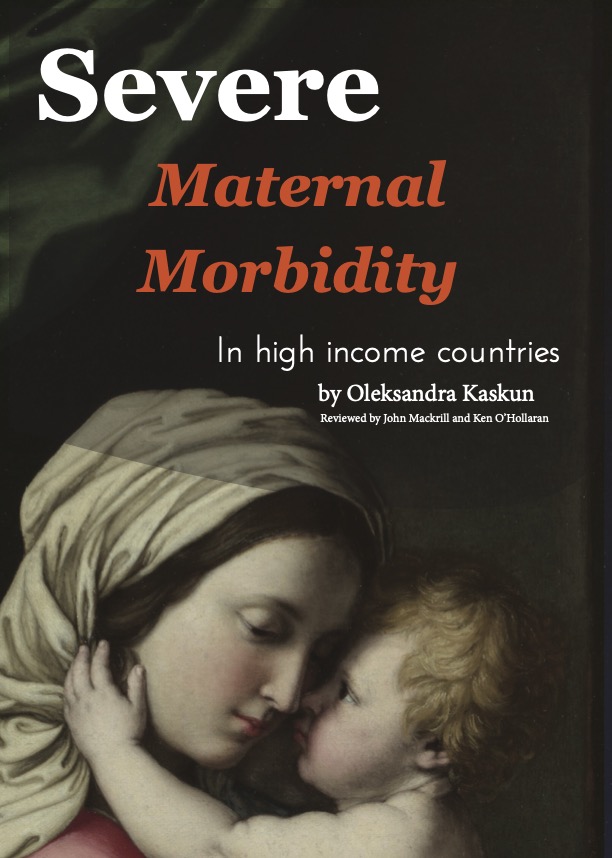Severe maternal morbidity in high income countries
DOI:
https://doi.org/10.33178/SMJ.2021.1.1Keywords:
maternal morbidityAbstract
Introduction
With declining maternal mortality rates in high income countries (HICs), severe maternal morbidity (SMM) is becoming an important quality measure of maternal care. However, there is no international consensus on the definition and types of SMM. This study aims to critically analyze published literature on SMM in HICs.
Objectives
To compare definitions and criteria used to identify SMM, and to identify the main types and risk factors contributing to SMM in eight HICs.
Methods
Three databases were searched, results were filtered, and ten studies were critically appraised.
Results
Six of the articles discussed SMM identification criteria and proposed definition modifications. Longer hospital stay and admission to intensive care unit were suggested as additional criteria. Disease-based criteria was shown to be superior to organ dysfunction criteria. Seven articles detailed common types of SMM as severe haemorrhage, hypertensive disorders, and pre-eclampsia/eclampsia. Six articles described SMM risk factors, of which advanced maternal age and caesarean delivery were most common.
Discussion
This literature review identified disease-based criteria and Canadian study criteria as promising measures of SMM. It also identified several types and risk factors of SMM common between HICs. These findings can help physicians identify women at risk of SMM. The study is however limited to eight HICs and ten studies. Further research should aim to investigate how the measures compare with previous sources of criteria, and to discern the association of weight and race risk factors with SMM.
References
Firoz T, Chou R, Von Dadelszen P, et al. Measuring maternal health: Focus on maternal morbidity. Bull World Health Organ. 2013;91:794–796.
Mengistu TS, Turner JM, Flatley C, Fox J, Kumar S. The Impact of Severe Maternal Morbidity on Perinatal Outcomes in High Income Countries: Systematic Review and Meta-Analysis. J Clin Med. 2020;9:2035.
Say L, Souza JP, Pattinson RC. WHO working group on Maternal Mortality and Morbidity classifications. Best Pract Res Clin Obstet Gynaecol. 2009;23(3):287-96
World Health Organization (WHO). Evaluating the Quality of Care for Severe Pregnancy Complications: The WHO Near-Miss Approach for Maternal Health; WHO: Geneva, Switzerland, 2011.
Leonard SA, Main EK, Carmichael SL. The contribution of maternal characteristics and cesarean delivery to an increasing trend of severe maternal morbidity. BMC Pregnancy Childbirth. 2019;19:16.
Lazariu V, Nguyen T, McNutt LA, Jeffrey J, Kacica M. Severe maternal morbidity: A population based study of an expanded measure and associated factors. PLoS ONE. 2017;12(8):1-13. (https:// journals.plos.org/plosone/article?id=10.1371/jour- nal.pone.0182343)
Leonard SA, Main EK, Carmichael SL. The contribution of maternal characteristics and cesarean delivery to an increasing trend of severe maternal morbidity. BMC Pregnancy Childb. 2019;19:16.
O’Malley EG, Popivanov P, Fergus A, Tan T, Byrne B. Maternal near miss: what lies beneath? Eur J Obstet Gynecol Reprod Biol. 2016;199:116-120.
Dzakpasu S, DebRinker P, Arbour L, et al. Severe maternal morbidity surveillance: Monitoring pregnant women at high risk for prolonged hospitalisation and death. Paediatr Perinat Epidemiol. 2020;34(4):427-439
Ghazal-Aswad S, Badrinath P, Sidky I, et al. Se- vere Acute Maternal Morbidity in a High-Income Developing Multiethnic Country. Matern Child Health J. 2013;17:399-404
Jayaratnam S, Kua S, deCosta C, Franklin R. Maternal ‘near miss’ collection at an Australian tertiary maternity hospital. BMC Pregnancy Childb. 2018;18:221.
Lipkind HS, Zuckerwise LC, Turner EB, et al. Severe maternal morbidity during delivery hospitalisation in a large international administrative database, 2008–2013: a retrospective cohort. Am J Obstet Gynecol. 2019;126:106-111
Mhyre JM, Bateman BT, Leffert LR. Influence of Patient Comorbidities on the Risk of Near-miss Maternal Morbidity or Mortality. Anaesthesiol. 2011;115(5):963-972.
Witteveen T, De Koning I, Bezstarosti H, et al. Validating the WHO Maternal Near Miss Tool in a high-income country. Acta Obstet Gynecol Scand. 2016;95:106-111
Zanconato G, Cavaliere E, Mariotto O, Zatti N. Perinatal outcome of severe obstetric complications: findings of a 10-year hospital-based surveillance study in Italy. Int J Womens Health. 2019;11:463-469
Scottish Confidential Audit of Severe Maternal Morbidity: reducing avoidable harm. 9th Annual Report. Scotland: Healthcare Improvement; 2011
Glynn L. A critical appraisal tool for library and information research. EBLIP Critical Appraisal Checklist Library Hi Tech; 2006
Lisonkova S, Potts J, Muraca GM, et al. Maternal age and severe maternal morbidity: A population-based retrospective cohort study. PLoS ONE. 2017;14(5):1-19.
Zwart JJ, Jonkers MD, Rickters A, et al. Ethnic disparity in severe acute maternal morbidity: a nationwide cohort study in the Netherlands. Eur J Public Health. 2011;21(2):229–234
Urquia ML, Glazier RH, Mortensen L, et al. Severe maternal morbidity associated with maternal birthplace in three high-immigration settings. Eur J Public Health. 2015;25(4):620-625.

Downloads
Published
License
Copyright (c) 2024 Oleksandra Kaskun

This work is licensed under a Creative Commons Attribution-NonCommercial 4.0 International License.









